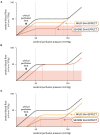Cerebral Autoregulation in Subarachnoid Hemorrhage
- PMID: 34367053
- PMCID: PMC8342764
- DOI: 10.3389/fneur.2021.688362
Cerebral Autoregulation in Subarachnoid Hemorrhage
Abstract
Subarachnoid hemorrhage (SAH) is a devastating stroke subtype with a high rate of mortality and morbidity. The poor clinical outcome can be attributed to the biphasic course of the disease: even if the patient survives the initial bleeding emergency, delayed cerebral ischemia (DCI) frequently follows within 2 weeks time and levies additional serious brain injury. Current therapeutic interventions do not specifically target the microvascular dysfunction underlying the ischemic event and as a consequence, provide only modest improvement in clinical outcome. SAH perturbs an extensive number of microvascular processes, including the "automated" control of cerebral perfusion, termed "cerebral autoregulation." Recent evidence suggests that disrupted cerebral autoregulation is an important aspect of SAH-induced brain injury. This review presents the key clinical aspects of cerebral autoregulation and its disruption in SAH: it provides a mechanistic overview of cerebral autoregulation, describes current clinical methods for measuring autoregulation in SAH patients and reviews current and emerging therapeutic options for SAH patients. Recent advancements should fuel optimism that microvascular dysfunction and cerebral autoregulation can be rectified in SAH patients.
Keywords: cerebral blood flow; cystic fibrosis transmembrane conductance regulator; delayed ischemia; microvascular dysfunction; stroke.
Copyright © 2021 Lidington, Wan and Bolz.
Conflict of interest statement
DL is a consultant for Qanatpharma AG (Stans, Switzerland). SS-B is executive board member of Qanatpharma AG and Aphaia Pharma AG (Zug, Switzerland). Neither Qanatpharma AG nor Aphaia Pharma AG had any financial or intellectual involvement in this article. The remaining author declares that the research was conducted in the absence of any commercial or financial relationships that could be construed as a potential conflict of interest.
Figures



Similar articles
-
Cerebral artery myogenic reactivity: The next frontier in developing effective interventions for subarachnoid hemorrhage.J Cereb Blood Flow Metab. 2018 Jan;38(1):17-37. doi: 10.1177/0271678X17742548. Epub 2017 Nov 14. J Cereb Blood Flow Metab. 2018. PMID: 29135346 Free PMC article. Review.
-
Impaired Cerebral Autoregulation After Subarachnoid Hemorrhage: A Quantitative Assessment Using a Mouse Model.Front Physiol. 2021 Jun 8;12:688468. doi: 10.3389/fphys.2021.688468. eCollection 2021. Front Physiol. 2021. PMID: 34168571 Free PMC article.
-
Clinical relevance of cerebral autoregulation following subarachnoid haemorrhage.Nat Rev Neurol. 2013 Mar;9(3):152-63. doi: 10.1038/nrneurol.2013.11. Epub 2013 Feb 19. Nat Rev Neurol. 2013. PMID: 23419369 Review.
-
Antioxidant Melatonin: Potential Functions in Improving Cerebral Autoregulation After Subarachnoid Hemorrhage.Front Physiol. 2018 Aug 17;9:1146. doi: 10.3389/fphys.2018.01146. eCollection 2018. Front Physiol. 2018. PMID: 30174621 Free PMC article. Review.
-
Predictive Value of Cerebral Autoregulation Impairment for Delayed Cerebral Ischemia in Aneurysmal Subarachnoid Hemorrhage: A Meta-Analysis.World Neurosurg. 2019 Jun;126:e853-e859. doi: 10.1016/j.wneu.2019.02.188. Epub 2019 Mar 9. World Neurosurg. 2019. PMID: 30862594
Cited by
-
Implantable Intracranial Pressure Sensor with Continuous Bluetooth Transmission via Mobile Application.J Pers Med. 2023 Aug 28;13(9):1318. doi: 10.3390/jpm13091318. J Pers Med. 2023. PMID: 37763086 Free PMC article.
-
Role of multimodal monitoring in the management of patients undergoing complex intracranial bypass procedures - A case series and literature review.Indian J Anaesth. 2023 Aug;67(8):743-746. doi: 10.4103/ija.ija_286_23. Epub 2023 Aug 15. Indian J Anaesth. 2023. PMID: 37693016 Free PMC article.
-
Intracranial Pressure Monitoring and Management in Aneurysmal Subarachnoid Hemorrhage.Neurocrit Care. 2023 Aug;39(1):59-69. doi: 10.1007/s12028-023-01752-y. Epub 2023 Jun 6. Neurocrit Care. 2023. PMID: 37280411 Free PMC article. Review.
-
Optimal cerebral perfusion pressure during induced hypertension and its impact on delayed cerebral infarction and functional outcome after subarachnoid hemorrhage.Sci Rep. 2024 Dec 16;14(1):30509. doi: 10.1038/s41598-024-82507-3. Sci Rep. 2024. PMID: 39681631 Free PMC article.
-
Evaluation of markers of cerebral oxygenation and metabolism in patients undergoing clipping of cerebral aneurysm under total intravenous anesthesia versus inhalational anesthesia: A prospective randomized trial (COM-IVIN trial).Brain Circ. 2023 Nov 30;9(4):251-257. doi: 10.4103/bc.bc_66_23. eCollection 2023 Oct-Dec. Brain Circ. 2023. PMID: 38284110 Free PMC article.
References
-
- Solenski NJ, Haley EC, Kassell NF, Kongable G, Germanson T, Truskowski L, et al. . Medical complications of aneurysmal subarachnoid hemorrhage: a report of the multicenter, cooperative aneurysm study. Participants of the multicenter cooperative aneurysm study. Crit Care Med. (1995) 23:1007–17. 10.1097/00003246-199506000-00004 - DOI - PubMed
Publication types
LinkOut - more resources
Full Text Sources

